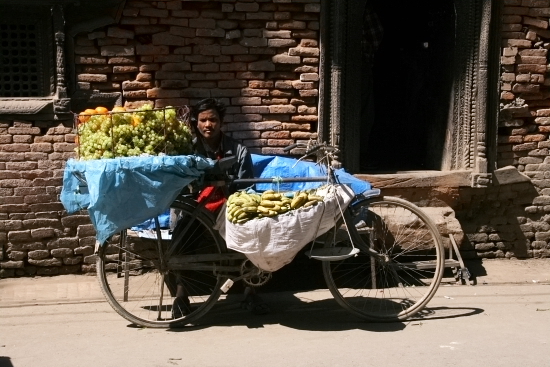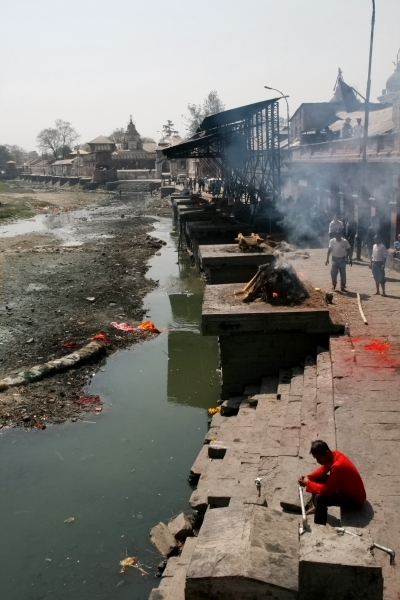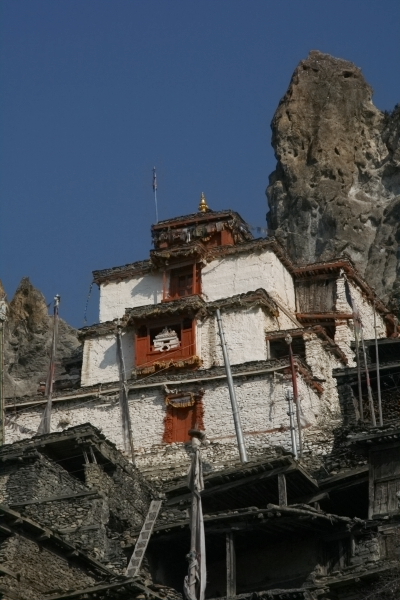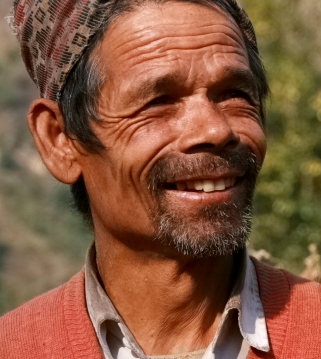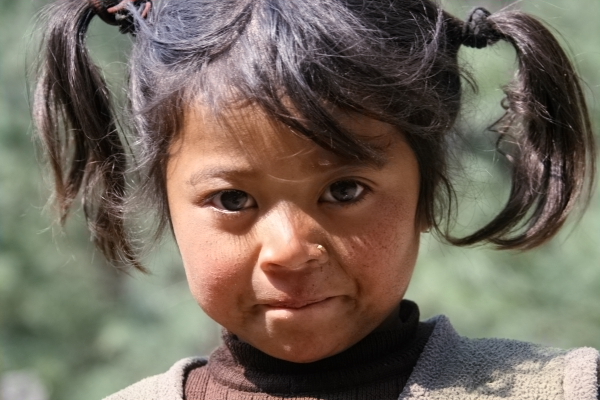nepal 25.02.09 - 13.04.09
Unable to cross Burma or China with our bike we are forced to take a plane from Bangkok to Kathmandu. Instead of flying with Thai Airways, were challenging our luck and hitch a ride with the cheap Royal Nepal Airlines. The plane definitely saw better times already but the service is excellent and, hey, we land in Kathmandu without any incidents!
At first I dont like the idea of arriving 1 day before the bike but it is actually by far better. This way were getting picked up by the staff of the hotel we booked in for the first 2 nights and can have a brief look around the area were staying before heading off for the airport again.
at the thorung la 5416m
The procedure to clear the bike from the customs seems easy at the beginning. Without any help we find the correct office, which is handing over the original freight papers and are send to the customs/warehouse 1,5km south. At the gate await us several fixers, who want to help us with the paperwork for additional costs.
At this time were sure we can fix everything on our own and were ignoring their pleads.
Very soon we learn that it is a common practise to use fixers for the procedures at the customs, it is even encouraged by the officers in charge. All the paperwork is in Nepali Sanskrit and the custom officers would rather drink another cup of tea than to tell us what to fill in
It is difficult to describe the situation in the combined customs/warehouse. The brick walled building is extremely dark inside; it is hard to read something in the offices and even harder to find your way in the gangway
Even the Airport compound is suffering from continues brown outs!
In the toilet there is a lone candle stuck to one of the sinks, upon entry youd need to get your eyes used to the darkness first before stepping any further.
The fixer and me are running through the offices and collecting signatures and stamps, 3 hours later we must have about 30 of them on the declaration form. In some of the offices the corners are being abused as spitting corners. Close to the entry/exit door the wall would be stained red with spit and the remains of betel nut or whatsoever. It seems to be normal practise to cough up your phlegm upon exit and leave it on the wall. This mucus would then follow the gravity and move slowly towards the carpeted floor, leaving a shiny stain
Only after the declaration form is completely full of stamps, signatures and markings Im asked for the Carnet de Passage. The officer in charge wants to know where the bike is but so do I!!!! I havent seen a hint of it yet.
Together were able to find my box, which is now being pushed out onto the street by several workers. The engine and chassis numbers are checked and from now on Im allowed to work on my bike.
It takes some concentration to be able to assemble the bike being under permanent supervision of at least 30 people.
Eventually the bikebox is beeing pushed out of the customs
What a beauty!!!!
The assembly of the bike is beeing watched over by some bystanders
Leaving the Airport compound my first move is to find a petrol station. Petrol stations in Kathmandu are not very easy to find. They are not colourful or distinct from the surroundings but, at least there is petrol available!!
Nepal hasnt got any oil itself and is importing all oil products from the neighbouring India. This situation makes it very vulnerable to strikes, which happen quite often in this country. So, most of the time there is no petrol available and you just got to wait
Im getting the first feeling for the traffic in Kathmandu riding to our hotel, bikes, people, cars, trucks and cows everywhere, moving in all imaginable directions, completely ignoring the road rules (is there any rules anyway??).
Impressions from the first walk in Kathmandu
A wandering holy man - Sadhu
Kathmandu is a strange place and we are more than eager to explore it. And there is almost too much to see for us.
We start with a walk to Kathmandus Durbar Square, where once the citys kings were crowned and legitimised. If it were no cars or motorbikes in here youd think youre transferred into the 15th century. There are small shops with windows hardly rising above the street level, all unlit or lit by candlelight. Meat is simply put out on a table in the baking sun only centimetres away from passing traffic. Further on we spot some Yogis, with their painted faces and coloured clothes a great photo opportunity. Also great are the ceremonies. It seems that wherever we walk, there would be some kind of celebrations.
There are girls sitting together with their parents and performing some kind of Hindu rituals, a skinhead boy with a swastika painted to his head is being a centre of a parade through the city accompanied by an immense noise originating from the following music band.
Then again, a monkey stole a plastic bag with something edible from a young boy and enjoys now its contents, while the boy has to watch in a safe distance.
The first few days in Kathmandu are immense. No matter where I look, there would be something happening. Besides the Durbar Square, were visiting some temples.
holy cow at the durbar square
A 6 months old child ready for the rice feeding ceremony
A butchery by day...
... and by night
Jane at the Durbar Squere in Kathmandu
The Pashupatinath temple is the most important site for Hindus in Nepal. As non Hindus were not allowed inside any of the actual temples but we are allowed to be witnesses to some cremations
(Not a very pleasant experience though).
From here we walk on and pass an obviously very important vagina temple. Its a shame we again cant go inside, Im more than interested what is accommodated inside!
Walking through some construction places we reach Bodnath, home to one of the worlds largest stupas.
cremations at the pashupatinath temple
sadhu at the pashupatinath temple
buddhas eyes at the bodnath temple
For us, Bodnath isnt very special, a huge concrete dome with lots of prayer flags and prayer wheels. But the surrounding atmosphere is very spiritual. Wherever we walk, there would be the om mani padme um sound following us and Buddhas eyes would follow us too
Having all things sorted out in the capital were ready for Pokhara and the Annapurna Circuit. We leave our bike and most of our gear at the guesthouse in Pokhara and take off with only the minimum on equipment for the long trek.
ANNAPURNA CIRCUIT
During 14 days we walk from Besishar anti clockwise the Annapurna Circuit, passing stunning scenery every single day of the trek. Its a great experience for both of us. We walk approximately 150 kilometres through the Himalayas, try some delicacies like yak cheese, yak curry or just dried yak meat and the famous Tibetan butter tea, and cross the hazardous Thorung La Pass with its 5416m in a snow storm. We get lost after the pass in a heavy snowfall and find our way later on, just as were thinking of our possibilities to sleep in the open at an altitude of 4000m
Janes enthusiasm for the snow is declining rapidly now!
While resting in Muktinath we decide not to complete the circuit and try to fly from Jomsom to Pokhara. The rest of the circuit isnt just the same like the eastern part. With the road to Muktinath finished there are suddenly so many people and so much traffic on the trek that it is not enjoyable for us any more. Still, we need to make it to Jomsom and fight the strong wind all the way in the Kali Gandaki Valley.
The last part of our Annapurna experience is the beautiful but short flight back to Pokhara. The little Cesna is following the valleys and were getting incredible mountain views all the way, almost touching Poonhill and getting very close to Macchapucchare, the Fishtail-Mountain.
annapurna 4 in first sun rays
annapurna 4 again
annapurna 3 and gangapurna
chorten at bhraga
faces of the himalaya
view of annapurnas in gunsang
janes first snow
too much snow for jane now
yakyakyakyakyak
ghyaru view
view of jharkot
We dont really like the idea of back tracing but this time we need to ride back to Kathmandu and apply for the Pakistani visa. The process is more of a job application than applying for a visa. We need to fill in 5 pages with some strange questions in strange English
There would be questions about education, specialties, work experience, and this for the applicant and for his complete family. Besides asking for my address 3 times in the forms, there is another question about my domicile. But, still the progress isnt too bad and after an interview and 2 days of waiting were getting our visas handed out for 36$ each.
Now, we finally can leave Kathmandu, its terrible traffic and shocking air pollution.
Were choosing the Rajpath Highway, the direct and oldest connection Kathmandus with the rest of the World. Endless hairpin bends, mostly one lane of tarmac and not too much traffic exactly what we want! On the way we quickly find out the reason for the lack of traffic. Another transportation strike is on and literally all tankers are parking beside the road. Nice, although we might have problems to refill our tank again
since 1992 and still kicking
Spending few days in the Chitwan National Park were able to explore the park per pedes.
Although we spot some crocodiles, deer, wild buffalo, different species of birds, the main attraction of the park the Rhinoceros doesnt appear until the last half hour of our whole day walk. 200 meters away and then only for 10 seconds we can see the huge mammal.
canoe in chitwan NP
paintings on a elephant
village boy in chitwan NP
who is pulling whom?
supermarket in tansen
Much luckier we are in the Bardia National Park. Here the young male Rhino comes almost too close, hehehe.
going to bardia NP
jane nepali style
rhino encounter in bardia NP
chapati and vegetables
On the day were leaving Bardia NP there is another strike on and road blocks being installed. Some tourists are stranded as they cant get a public transport anywhere
remains of a recent road block
road scene from nepal
Nepal is a beautiful country but it has many problems, which affect the tourism industry directly. People trying to extort money from passing traffic by blocking the highway deliberately, the permanent lack of gasoline due to strikes and the constant power cuts make travelling difficult if not unpleasant.







